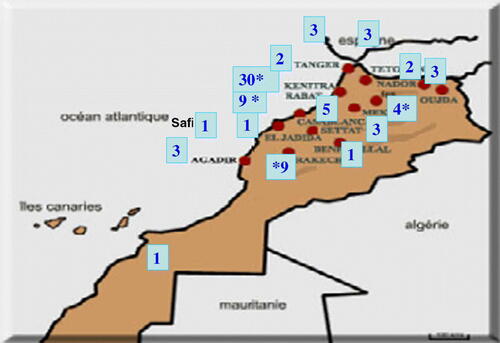Morocco is a North African country with 34 million inhabitants. Its capital is Rabat, and the country consists of 16 states. Its healthcare system is organized into three systems: 1) the public system, which is the responsibility of the Ministry of Health and includes a) tertiary-level university hospitals (in Rabat, Casablanca, Marrakech, and Fès), b) other public hospitals (secondary level), including provincial, regional, and local hospitals, and c) health centres (primary level), including urban, communal, and rural health centres; 2) the military system, with five large hospitals; and 3) the private system, including clinics and private health centres Citation[1].
There is great disparity between the big cities and smaller towns, and especially rural areas. Accessibility to medical care is limited, especially in rural areas, where 31% of the rural population lives further than 10 km from the nearest medical unit Citation[2].
In 2001, the total number of physicians, including both specialists and GPs, was reported to be 13 994: 6492 (46.4%) in the private sector, 6055 (43.3%) in the public non-university sector, 767 (5.5%) in the military sector, and 679 (4.9%) in the university-hospital sector Citation[1]. The overall number has increased more than 13-fold between 1960 (1096) and 2004 (15 242) Citation[3].
There is one physician per 2084 inhabitants in Morocco. However, physician distribution is uneven, with the greatest concentration (44.5%) being in Rabat and Casablanca (15% of the country's population) Citation[1].
In the public sector, patients are required to be referred via a GP to specialists, but in the private sector the patient has direct access to specialists.
The training of GPs differs from region to region. In the big cities, GPs are well organized, and representatives of the Ministry of Health regularly arrange courses given by medical-school professors. This is also the case in the private sector (mainly in the big cities), where the same courses are given but are sponsored by the pharmaceutical industry.
Concerning general working conditions, these are usually quite good, and the Ministry of Health has built hospitals and medical centres that contain highly sophisticated equipment. However, the distribution of these centres is insufficient, especially in rural areas.
Regarding staff, both specialists and GPs are well staffed with nurses and/or administrators. However, there exists a significant gap between university hospitals and non-university hospitals, and there is often an absence of collaboration between them.
Concerning the distribution of specialists, there is great inequality between the big cities. For example, in neurology, there are only 80 specialists in the entire country, and these are concentrated in Rabat and Casablanca (more than 50%) (see ).
References
- Santé en Chiffres 2002. Direction de la planification et des ressources financieres, Division de la planification et des etudes service des etudes et de l'information sanitaire. Royaume du Maroc Ministère de la santé http://www.sante.gov.ma/Departements/DPRF/SEIS/Docs/2002.pdf .
- Annual report of Moroccan Ministry of Economic Prevision and Planning, Programme Department.
- Department of Human Resources. Situation of human resources in the Ministry of Health. Rabat: Ministry of Health, Department of Human Resources; 2006.
